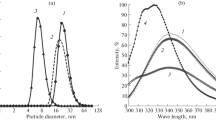Abstract
The minimum concentration of polyethyleneglycol (PEG) with molecular weights 4000, 6000, and 15000 necessary for precipitation of S, M, X and Y potato viruses was determined. An excessive amount of PEG causes the precipitation of other protein compounds from potato leaf cell sap. In order to obtain highly purified samples, it is necessary to use just the minimum sufficient amount of PEG. Using the minimum quantity of PEG is, also, advisable from an economical point of view. The minimum concentration of PEG of given molecular weight differs for different potato disease viruses. The concentration of PEG necessary for precipitation of a given potato virus depends on the molecular weight of PEG used—4000, 6000 and 15000. As the molecular weight increases, the concentration of PEG necessary for precipitation decreases.
Abstract
Stanovili jsme minimální procentické množství tří druhů polyethylenglykolu (PEG) o m. v. 4000, 6000, 15000, které jo zapotřebí ke srážení S, M, X a Y virů bramboru. Nadbytečné množství PEG vysráží další bílkovinné složky ze štáv z listů rostlin bramboru. Abychom dosáhli purifikáty nejvyšší čistoty je proto zapotřebí dodržet minimálně potřebné množství PEG. Dodržení minimálního množství PEG je také vhodné z ekonomického hlediska. Minimální koncentrace PEG jednoho molekul. druhu potřebná ke srážení je různá pro různé druhy virů způsobujících choroby brambor. Jeden a tentýž virus se sráží při různých koncentracích PEG o m. v. 4000, 6000, 15000, přičemž koncentrace PEG potřebná ke srážení klesá se stoupající molekulovou vahou PEG.
U S a M virů izolovaných z rostlin bramboru a X viru izolovaného z rostlin tabáku se ukázala jako nejvhodnější homogenizace listů po předchozím mražení s 0,007m fosfátovým pufrem o obsahu 0,007m EDTA, 0,01m natrium diethylbarbiturátu a 0,01m cysteinu nebo cysteinhydrochloridu a o pH 7,4 (CE pufr). Odstranění chloroplastových zbytků bylo provedeno Cellitem. Při izolaci Y-viru vyhovovala nejlépe homogenizace CE pufrem bez předchozího mražení a odstranění chloroplastových zbytků Cellitem.
Similar content being viewed by others
References
Albrechtová, L., Klír, O.: The isolation of potato virus S from the leaves of potato plants using precipitation by polyethyleneglycol.—Biol Plant.10: 271–274, 1968.
Albrechtová, L.: Příprava antiséra k S viru bramboru za použití antigenu připraveného srážením polyethylenglykolem. [Preparation of S virus antiserum by means of antigen prepared by polyethylene glycol precipitation.]—Sborník ÚVTI, Ochrana rostlin (in press). 1970.
Bartels, R.: Ein Beitrag zum serologischen Nachweis des Y-Virus in der Kartoffel.—Phytopathol. Z.30: 1–16, 1957.
Brandes, J.: Identifizierung von gestreckten pflanzenpathogenen Viren auf morphologischer Grundlage.—Mitteil. Biol. Bundesanstalt Land-Forstwirtschaft 110, 1964.
McClendon, J. H.: Physical environment of chloroplasts as related to their morphology and activityin vitro.—Plant Physiol.24: 448–458, 1954.
Corbett, M. K.: Some distinguishing characteristic of the orchild strain of tobacco mosaic virus.—Phytopathology57: 164–172, 1967a.
Corbett, M. K.: Aster ringsport virus as strain of tobacco rattle virus.—Phytopathology57: 198–202, 1967b.
Gooding, G. V., Hebert, T. T.: A simple technique for purification of tobacco mosaic virus in large quantities.—Phytopathology57: 1285, 1967.
Hampton, R. E., Fulton, R. W.: The relation of polyphenol oxidase to instability in vitro of prune dwarf and sour cherry necrotic ringspot viruses.—Virology13: 44–52, 1961.
Hebert, T. T.: Precipitation of plant virus by polyethylene glycol.—Phytopathology53: 362, 1963.
Jermoljev, E.: Diagnostika virových chorob bramborů a řepy cukrové. [Diagnostic Methods of Virus Diseases of Potato Plants and Sugar Beet.]—Academia, Praha, 1967.
Jermoljev, E., Albrechtová, L.: Stabilization of purified potato virus X by dextran T-10 during lyophilization.—Biol. Plant. 0000.
Van Kammen, A.: Purification and properties of the components of cowpea mosaic virus.— Virology31: 633–642, 1967.
Lebermann, R.: The isolation of plant viruses by means of “simple coacervate”.—Virology30: 341–347, 1966.
Polson, A., Potgieter, G. M., Largier, J. F., Mears, G. E. F., Joubert, F. I.: The fractionation of protein mixtures by linear polymers of high molecular weight.—Biochim. biophys. Acta82: 463–475, 1964.
Zeppezauer, M., Briskammar, S.: Protein precipitation by uncharged water soluble polymers.—Biochim. biophys. Acta94: 581–583, 1965.
Author information
Authors and Affiliations
Additional information
Address: Praha-Ruzyně č. 507, Czechoslovakia.
Rights and permissions
About this article
Cite this article
Albrechtová, L., Klír, O. Precipitation of S, M, X and Y potato viruses by polyethyleneglycols with different molecular weights. Biol Plant 12, 31–40 (1970). https://doi.org/10.1007/BF02920876
Received:
Published:
Issue Date:
DOI: https://doi.org/10.1007/BF02920876




